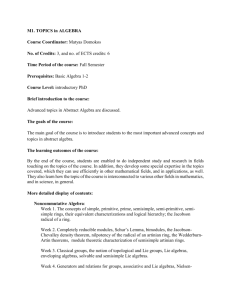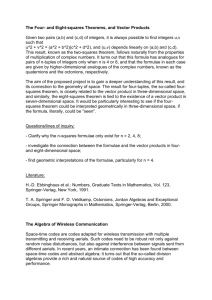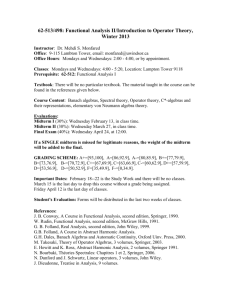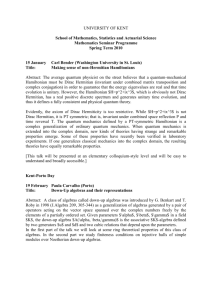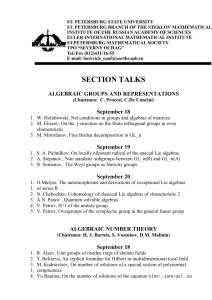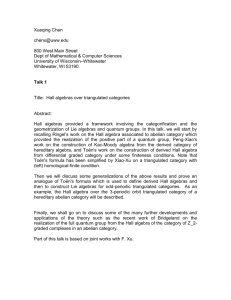Algebraic and geometric Aspects in Mathematical Physics
advertisement
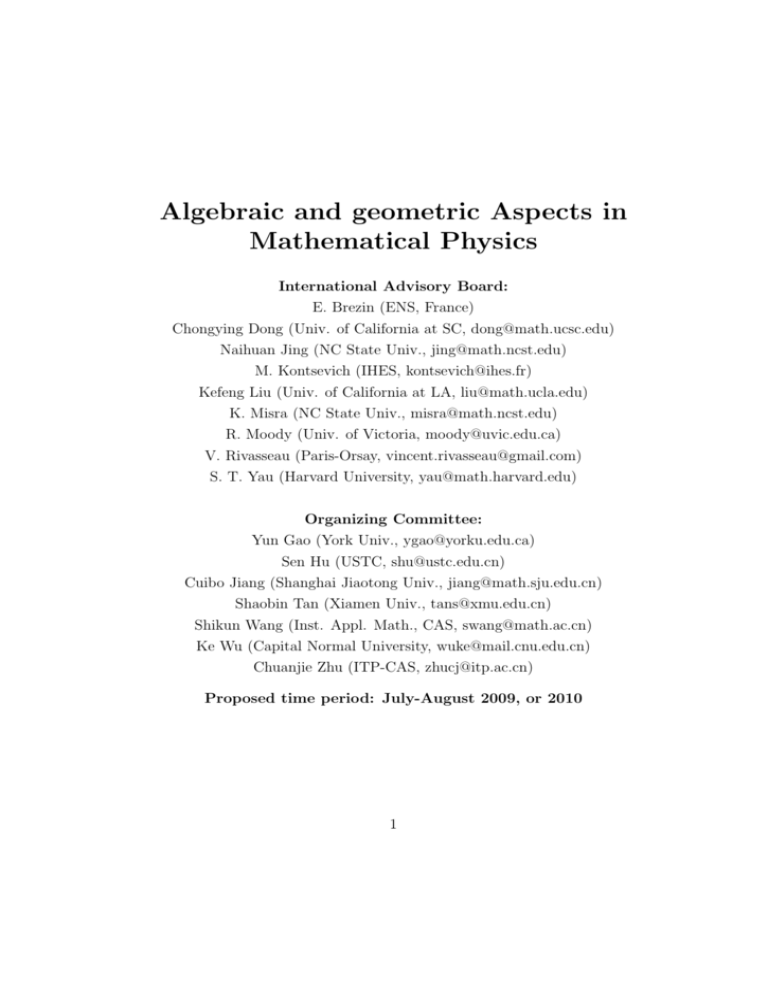
Algebraic and geometric Aspects in Mathematical Physics International Advisory Board: E. Brezin (ENS, France) Chongying Dong (Univ. of California at SC, dong@math.ucsc.edu) Naihuan Jing (NC State Univ., jing@math.ncst.edu) M. Kontsevich (IHES, kontsevich@ihes.fr) Kefeng Liu (Univ. of California at LA, liu@math.ucla.edu) K. Misra (NC State Univ., misra@math.ncst.edu) R. Moody (Univ. of Victoria, moody@uvic.edu.ca) V. Rivasseau (Paris-Orsay, vincent.rivasseau@gmail.com) S. T. Yau (Harvard University, yau@math.harvard.edu) Organizing Committee: Yun Gao (York Univ., ygao@yorku.edu.ca) Sen Hu (USTC, shu@ustc.edu.cn) Cuibo Jiang (Shanghai Jiaotong Univ., jiang@math.sju.edu.cn) Shaobin Tan (Xiamen Univ., tans@xmu.edu.cn) Shikun Wang (Inst. Appl. Math., CAS, swang@math.ac.cn) Ke Wu (Capital Normal University, wuke@mail.cnu.edu.cn) Chuanjie Zhu (ITP-CAS, zhucj@itp.ac.cn) Proposed time period: July-August 2009, or 2010 1 1 Program description Quantum field theory and string theory have been major sources of inspirations for mathematics for several decades. There have been deep interactions between them with mathematics through algebra and geometry. We would like to pursue those two aspects in this project. There will be two aspects: algebraic aspects emphasizing representations of infinity dimensional algebra and its connections with D-branes and boundary conformal field theory and geometric aspects emphasizing new string vacua coming from generalized Calabi-Yau and through them to study flux compactifications in string theory and various applications. In the study of vacua of string theory there are two dual methods: one is through low energy effective theory, i.e super-gravity and another one is through world sheet theory, i.e. conformal field theory. The formal is connected with geometric structures and the latter is connected with representations of infinite dimensional algebras. In the recent development of string theory flux compactifications has been a focus of study. Many new vacuas have been found through a new geometric structure that is generalized geometry. The concept of generalized geometry was introduced by Hitchin several years ago and it was further pursued by Gualtieri and others. A generalized SU(3) x SU(3) structure is a generalized Calabi-Yau structure. To incoporate NS and RR fluxes into a supersymmetric background in Type II strings one is naturally led to generalized geometry. For Heterotic strings the systems of equations to describe a string vacua were derived by Strominger. In the recent work of ST Yau and his collaborators they constructed many new interesting solutions. The representation theory of infinite-dimensional Lie algebras has been one of the most active and fruitful areas of modern mathematics in the last several decades. The representation theory of affine Kac-Moody Lie algebras, extended affine Lie algebras, quantum groups and vertex algebras are deeply related to many important areas of mathematics and physics, such as automorphic forms, quantum groups, index theory, orbifold theory, mirror symmetry, conformal field theory and string theory. The core of representation theory of infinite dimensional Lie algebras is the vertex operator representations. The term “vertex operators” was first used by physicists in the theory of dual resonance theory. The first vertex operator realization of affine Kac-Moody algebra was given by Lepowsky and Wilson. The untwisted vertex operator realizations of the basic representa2 tions of the simply-laced affine algebras by Frenkel-Kac and Segal played a significant role in Borcherds’ formulation of vertex algebra which is essentially the chiral algebra in conformal formal field theory in physics. The vertex operators were also used in the construction of moonshine vertex algebra by Frenkel-Lepowsky-Meurman. Borcherds proved the Conway-Norton’s moonshine conjecture for this vertex algebra. This program will focus on recent progress in the representation theory of infinite-dimensional Lie algebras, quantum groups and vertex algebras and their applications to other fields. Since geometry and physics are also parts of the program, there will be two major underlying themes: interrelations between algebraic and geometric methods, and interplays between mathematical and physical perspectives on representation theory. The main topics are: 1. Vertex algebras and their representations. There are two main problems. The first one is to characterize and classify rational vertex operator algebras. The other is to determine the various module category for a rational vertex operator algebra. Rational vertex operator algebras, which play a fundamental role in rational conformal field theory, single out an important class of vertex operator algebras. Rational conformal field theory can be constructed from a complete sets of irreducible representations of a pair of rational two identical vertex operator algebras. These problems are closely related to classification of rational conformal field theory. There is a lot of interests in physics recently on boundary CFT and D-branes. The question is how to put these physics theory into a rigorous mathematical theory. This is certainly related to some unknown representations – “solitonic representations” for vertex operator algebras. The notion of moonshine used today is relationship between vertex operator algebras, modular forms and finite groups. There are two outstanding problems in this direction. One is the Norton’s generalized moonshine conjecture which says that one can associate genus zero modular functions to commuting pairs of elements in the monster simple group. The Norton’s conjecture can be understood in the framework of the representation theory of so called “holomorphic orbifold models.” In fact one can study orbifold theory for any vertex operator algebra together with a finite automorphism group, and only the genus zero condition marks the moonshine vertex operator algebra as special. The other problem is the Frenkel-Lepowsky-Meurman’s conjecture on uniqueness of the moonshine vertex operator algebra. This conjecture is part of the classification of holomorphic vertex operator algebras of central charge 24. These two 3 problems are related to generalized Kac-Moody Lie algebras and automorphic forms. 2. Extended Affine Lie Algebras and their Representations. Kac-Moody Lie algebras have various generalizations from different contexts developed by R. Borcherds, P. Slodowy, and some others. The notion of extended affine Lie algebras is a natural generalization of affine Kac-Moody Lie algebras which can be viewed as central extensions of multi-loop Lie algebras. Some of the key players such as quantum torus and cyclic homology in the noncommutative geometry enters into the picture of the structure of extended affine Lie algebras. Extended affine Lie algebras include affine Lie algebras and toroidal Lie algebras and Lie algebras based on quantum torus. Further topics are extended affine root systems (including elliptic root systems) and extended affine Weyl group. 3. Infinite dimensional Lie algebras, vertex algebras and index theory. The connection between the representation theory of affine Kac-Moody algebras and index theory backed to Witten’s work on elliptic genus. Liu used the modular invariance of the characters of certain representations for affine Kac-Moody algebras to prove the rigidity of the elliptic genus. Recent work by Dong-Liu-Ma shows that elliptic genus and elliptic cohomology should be understood in terms of framework of vertex operator algebras. A geometric interpretation of monstrous moonshine is expected by using the index theory involving vertex operator algebras. 4. Quantum Groups and Their Representations. A major development in the representation theory of quantum groups was the discover by Kashiwara and Lusztig of a natural bases for the positive part of the quantized enveloping algebra of a Kac-Moody Lie algebra. the so-called global crystal bases or canonical bases. These bases also lead to natural bases in the representations of affine Lie algebras. While, the bases associated to the positive level representations of affine Lie algebras has been extensively studied, the corresponding results for level zero representations are not well–understood as yet. It is known for instance that not all level zero representations admit such bases. Kashiwara has some conjectures which list all level zero modules which admit crystal bases, although it is not yet been proved that in fact these modules have a crystal base to begin with. Partial results due to Kashiwara are known in the case of fundamental level zero modules. The theory of such bases has a very important combinatorial ingredient known as a crystal. This has been generalized to the notion of virtual crystals, the representation theoretic aspect of their objects are far from clear and should be interest4 ing to develop. The theory of quivers and quiver varieties was developed by H. Nakajima to study representations of Kac–Moody Lie algebras and level zero representations of quantum affine algebras. The initial geometric approach using an example of a quiver variety of type A, the cotangent bundle of the n–step partial flag variety was developed by Ginzburg and Vasserot to study these representations for quantum affine sl(n). Moreover, the irreducible finite-dimensional representations of quantized affine algebras play a key role in the theory of quantum integrable systems. The structure of these representations is quite complicated and there are a number of approaches to studying them. Two of these approaches have had significant success recently. One is the approach of q-characters, an idea that was introduced by Frenkel and Reshetikhin and further studied by Frenkel and Mukhin. It could be used to solve a conjecture on the structure of a particular family of modules, the so-called Kirillov-Reshetikhin modules. This also allowed people to establish that these characters solved a system of equations called the Q-system arising in the study of integrable systems. In order to study flux compactifications one needs to study the moduli space of generalized Calabi-Yau manifolds and establish a special geometry over such a space. The moduli space of generalized Calabi-Yau structure and its special geometry was studied by Grana-Louis-Waldram and by Tomassielo. Hou-Hu-Yang did some works to establish a mathematical foundation. Koerber and Martucci studied D branes and its moduli space. For the extended moduli space with fluxes there will be dualities corresponding to various compactifications. For example, generalized geometry is a good framework to study mirror symmetry. People proposed mirror symmetry to be exchanging two generalized complex structures for a generalized Calabi-Yau. A precise proposal is needed for the general background. Deep studies of mirror symmetry were established by Lian-Liu-Yau and others. It is a great challenge in mathematics to establish mirror symmetry for generalized Calabi-Yau at this level. String theory with NS fluxes are naturally connected with non commutative field theory, e.g. through works of Seiberg-Witten. There are breakthough in renormalization of non commutative field theory by works of Rivasseau and his collaborators. It would be fruitful to explore the theory and its connections with string theory. There are much works on world sheet theory over a general manifold. It was found that sigmal model over a generalized manifold obeys N=2 supersymmetry. The corresponding conformal field theories are of great interests. 5 It was also found that D branes of a generalized manifold are simply generalized submanifold which are also calibrated by forms. The corresponding theory provides clues to non-perturbative information of the more general string theory with fluxes. They provide many new problems to the study of algebraic part of strings. Hence the algebraic aspects and geometric aspects are deeply connected. There would be many problems and applications connected to flux compactifications. For example one could study black hole attractor mechanism, gauge-gravity correspondence and moduli stabilization. 2 Organization Outlines The purpose of this program is intended to bring together people who work on the representation theory of infinite dimensional Lie algebras, quantum groups and vertex algebras with people working on physics, generalized complex geometry, algebraic and geometric aspects of the representation theory. We shall invite senior scientists working in these areas mentioned above as key participants to this program. Participants, particularly young researchers and students will be selected. We will start with several introductory tutorials given by experts for the graduate students and postdoctoral fellows who are in the initial stages of their career in these fields in the first three weeks. Tutorials include: Infinite dimensional Lie algebras; Vertex operator representations; Automorphic forms and the moonshine; Quantum groups; Algebra and geometry; Generalized complex geometry; string compactifications and renormalization of non commutative field theory. During the last week, we would like to have a workshop to attract more experts from China and other countries relevant to the program to give talks. 3 Potential participants: 1. Algebraic aspects: Chengmin Bai (Nankai Univ., cmbai@math.nankai.edu.cn) G. Benkart (Univ. of Wisconsin, benkart@math.wisc.edu) S. Berman (Univ. of Sask., berman@snoopy.usask.ca) 6 D. Bernard (ENS Paris, denis.bernard@ens.fr) R. Borcherds (Univ. of California at Berkeley, borcherds@math.berkeley.edu) Xiangmao Ding (Inst. Appl. Math., CAS, xding@math.ac.cn) E.Frenkel (Yale Univ., frenkel@math.yale.edu) Yun Gao (York Univ., ygao@yorku.edu.ca) K. Gawedzki (ENS-Lyon, kgawedzk@ens-lyon.fr) R. Griess (Univ. of Michigan, griess@math.umich.edu) Naihong Hu (ECNU, nhhu@euler.math.ecnu.edu.cn) Haisheng Li (Univ. of Rutgers, li@camden.rutgers.edu) G. Lepowsky (Univ. of Rutgers, lepowsky@math.rutgers.edu) Yanan Lin (Xiamen Univ., ynlin@xmu.edu.cn) G. Mason (Univ. of California at SC, mason@math.ucsc.edu) T. Miwa (Kyoto, Japan) K. Nagatomo (Osaka Univ., nagatomo@math.osaka.edu.jp) E. Neher(Univ. of Ottawa, neher@math.uottawa.edu.ca) Liangang Peng (Sichuan Univ., penglg@mail.sc.cninfo.net) Yucai Su (USTC, ycsu@ustc.edu.cn) Nanhua Xi (Inst. Math., CAS, nanhua@math.ac.cn) Jie Xiao (Tsinghua Univ., jxiao@math.tsinghua.edu.cn) Xiaoping Xu (Inst. Math., CAS, xiaoping@math.ac.cn) Ming Yu(ITP, yum@itp.ac.cn) Hechun Zhang (Tsinghua Univ., hzhang@math.tsinghua.edu.cn) Kaimin Zhao (Inst. Math., CAS, kzhao@math.ac.cn) 2. Geometric aspects: K. Becker (Texas AM) M. Becker (Texas AM) Bo Feng (Zhejiang University) Jixiang Fu (Fudan, majxfu@fudan.edu.cn) Gao Yihong (ITP-CAS, gaoyh@itp.ac.cn) R. Goto (Osaka University) M. Grana (ENS-Paris, mariana.grana@cea.fr) M. Gualtieri (MIT) B. Hou (Northwest University, byhou@nwu.edu.cn) S. Hu (USTC, shu@ustc.edu.cn) P. Koerber (Max Planck, koerber@mppmu.mpg.de) 7 M. Kontsevich (IHES, kontsevich@ihes.fr) D. Kosower (CEA Saclay, david.kosower@cea.fr) M. Li (ITP-CAS, mli@itp.ac.cn) K. Liu (UCLA and Zhejiang University, liu@math.ucla.edu) J. Magnen (Ecole Polytechnique, Jacques.Magnen@cpht.polytechnique.fr) L. Martucchi (Muenchen, luca.martucci@physik.uni-muenchen.de) R. Minasian (CEA Saclay, Ruben.MINASIAN@cea.fr) B. Pioline (Paris VI, pioline@lpthe.jussieu.fr) V. Rivasseau (Paris-Orsay, vincent.rivasseau@gmail.com) A. Tomassiello (Harvard, US) L. Tseng (Harvard, US) Wallet (Paris-Orsay, jean-christophe.wallet@th.u-psud.fr) Wang Shikun (AMSS-CAS, wsk@math.ac.cn) Wu Ke (Capital Normal University, wuke@mail.cnu.edu.cn) Hao Xu(Zhejiang University, xuhao@cms.zju.edu.cn) S. T. Yau (Harvard, yau@math.harvard.edu) Z. Yin(USTC, yinzheng@ustc.edu.cn) C. Zhu (ITP-CAS, zhucj@itp.ac.cn) 8

